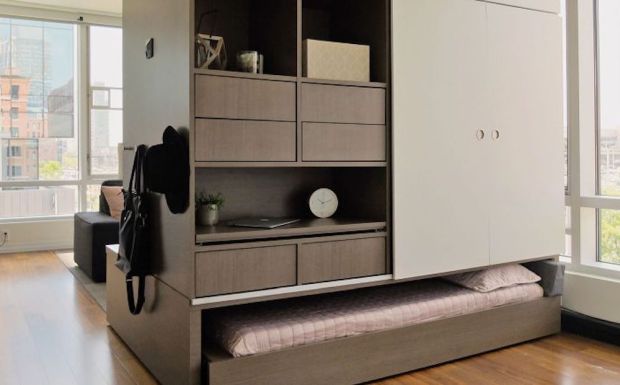Is The Future Of Furniture Robotic?

As Americans — particularly younger Americans — are becoming increasingly urban, they are needing to learn to think differently about space. In New York City, the average studio has only 550 square feet, while the average one bedroom clocks in with a not-exactly-cavernous 750 average square footage. In San Fransisco, the figures are similar — and in most of the nation’s top cities, 750-850 are considered about the norm. Somewhat less expensive markets have somewhat larger apartment homes on offer — 1,000 or so square feet tends to run at more the norm.
We should note that apartments are getting smaller — in 2009, the average NYC apartment was around 1,000 square feet.
Compare that with the average size of an American home, which has been growing while the apartment size has been shrinking down. In 1973, the average size of a new U.S. home was about 1,600 square feet — as of 2017, that figure is somewhere between 2.,400 – 2,600 feet.
Perhaps there was a point where the lines crossed — when the average home size and the average apartment size were within 500 square feet of each other. But these days, given the approximately 2,000 square foot difference between the the two types of structure, it is something of an understatement to note that the furnishing needs of house and apartment dwellers are rather different.
The “innovative” solution for apartment residents thus far has been a combination of 2/3-sized versions of most household furniture married to some very creatively conceived shelving. Some people have great taste and make tiny chic work. Others end up looking like they are still living in a dorm room. But when space is at a premium — as it is almost certain to be in cities like New York and Miami, until global warming puts them under water — options are limited.
Which is where Ori enters the story — the furniture robot that wants to help urban dwellers radically rethinking their spaces.
Yes, we said furniture robot.
Described by a Wired writer as:
“A hulking piece of furniture that sat pressed against the wall. From the front it looked like an entertainment console with built-in shelving. From the side, it appeared to be a regular bookshelf, save for a small button. At nine feet tall, five feet wide and seven feet long, the thing took up nearly a fourth of the apartment’s main living area, leaving just enough space for what could either be a living room or bedroom, but definitely not both.”
So why give a quarter of one’s living space to a hulking — something — that eats up most of the room? Well, Ori is more than meets the eye.
Ori is short for origami, which is the animating feature behind Ori, pun fully intended. With a push of a button or a command correctly given, Ori becomes what the user wants. A bed, a couch, a closet — whatever the user requires. There are a variety of ways to operate it, but one favored method is commanding Ori through Amazon’s Alexa.
“Millennials are looking for frictionless experiences,” Hasier Larrea, one of Ori’s co-founders, noted in an interview. Frictionless, perhaps, but not inexpensive — an Ori unit goes for $10,000. Ori’s parent firm sells both to individual consumers and to real estate developers thinking outside of the box about potential perks for residents.
Ori also bucks conventional wisdom when it comes to selling goods for small-scale decorating projects, which says think tiny in terms of what is on offer. Ori is not tiny — and as such, can seem like a counter-intuitive way for people living in small spaces to try to conserve their already at-a-premium room.
But, according to Larrea, the idea behind Ori isn’t trying to help users create more space, but instead about helping them use the spaces they already have better. A one or two bedroom apartment in most major metros in the U.S. is outside the price range of the average millennial shopper, but Ori allows that same shopper to get the function of that space in a smaller apartment by offering a walk-in closet, bedroom, dedicated work space, and living room. A $10,000 robotic furniture unit is certainly quite a bit more than what one might spend on a nice shelving and loft-bed purchase at Ikea — but certainly in the realm of things a working human can afford, which is more than one can say for rents on most of the island of Manhattan at present.
So will robotic furniture disrupt the chair? Probably not in the ’burbs, where people trying to fill homes pushing 3,000 square feet need to optimize their space less than they need to fill it. But where the dwellings seem to be getting progressively smaller, urbanites might like a furniture piece than can do a bit of everything and do it on demand.
Maybe the chair can stand some disruption after all.
